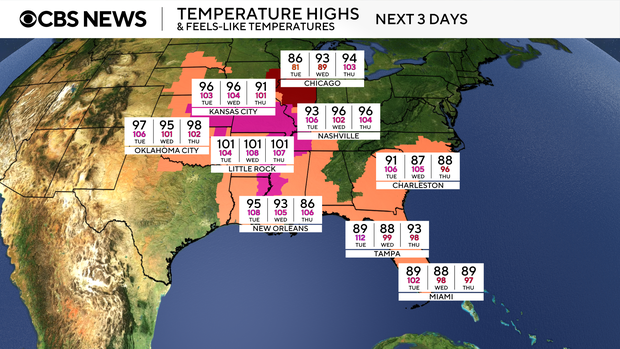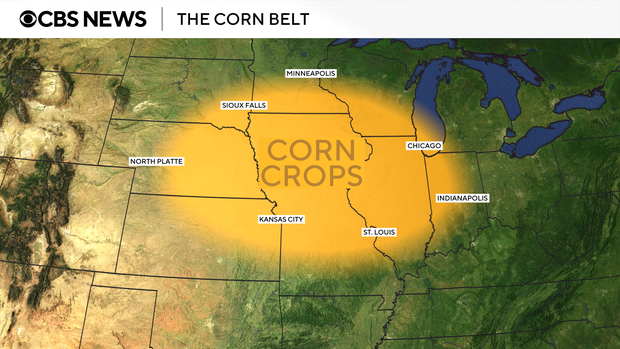A heat dome is trapping over 90 million Americans in extreme temperatures this week with the National Weather Service issuing heat alerts from Nebraska to Florida.
Dangerous heat threatens to bake much of the Mississippi Valley and parts of the U.S. Southeast from Tuesday through at least Thursday, with temperatures over 100 degrees expected in some areas. Some places could see heat index values, or feels-like temperatures, 110 to 115 degrees.
While not expected to reach record highs, temperatures are still forecasted to be about 10 to 15 degrees above average compared to what they typically are this time of year.
Maps show July heat alerts and forecasts
Nikki Nolan/CBS News
As the extreme heat hits parts of the Corn Belt, a region over part of the Plains and Central Mississippi Valley where heat index values could reach between 105 and 110 degrees, high humidity is also expected. The common phenomenon is known as corn sweat, which occurs when extreme heat beats down on corn crop and causes it to perspire and increase the humidity in the air.
Although record highs aren’t forecasted this week, overnight lows in the mid 70s to low 80s could possibly break record high minimums in states like Alabama, Arkansas, Florida, Georgia, Kentucky, Louisiana, Missouri, South Carolina and Tennessee, according to Climate Central, a nonprofit that analyzes climate change data.
High humidity coupled with extreme temperatures is dangerous because the combination significantly increases the likelihood of heat-related illnesses. Little to no overnight relief also poses a greater threat to health, NWS Prediction Center says.
Nikki Nolan/CBS News
Nikki Nolan/CBS News
Heat waves increasingly intensified by climate change
Climate change has made excessive heat in July at least three times more likely for nearly 160 million people in the U.S., nearly half the population, a Climate Central analysis found.
Using its calculation of data and what is called a Climate Shift Index (CSI), the nonprofit said Monday that human-caused climate change made this extreme heat at least five times more likely for certain areas, from Salt Lake City and Santa Fe, New Mexico, to Tallahassee, Florida, and Montgomery, Alabama.
The CSI uses real-time data to estimate how climate change has increased the likelihood of a particular daily temperature, according to Climate Central.
Last month, another heat dome exposed nearly half of the country to dangerously high temperatures. On June 24, seven states tied or broke monthly high temperature records, many exceeding triple digits. One of those states, Maryland, reported that 472 people needed medical assistance for heat-related illnesses during that time when the heat index topped 110 degrees in some places.
With such events becoming more common, Democratic lawmakers last week proposed legislation to classify extreme heat as a disaster, which would allow federal funding to flow into areas where hotter temperatures cause significant physical and economic distress.



